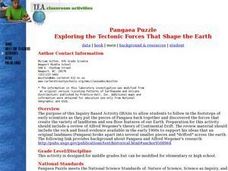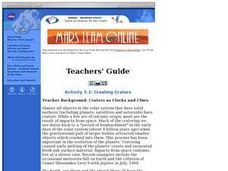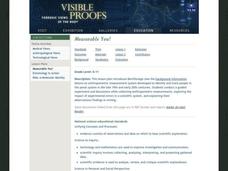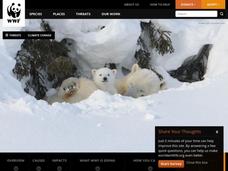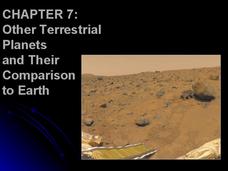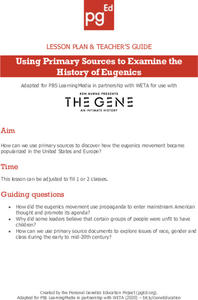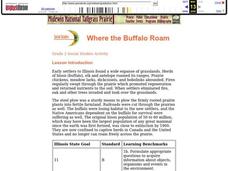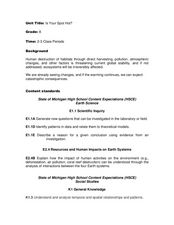Howard Hughes Medical Institute
Human Feet Are Strange
Feet are neat! So, if you've already walked the path of examining animal footprints with your class, put them in the shoes of early humans! A well-designed activity incorporates video, discussion, and hands-on learning to demonstrate how...
Curated OER
Inventions 2: The Impact
Students explore the process of inventing a new product. For this inventions lesson, students explore a timeline that gives a history on significant inventions from ancient times to the present. Students look at pictures of the...
Curated OER
Oil: Impact of a Resource
Learners discover the history and method of oil production. In this natural resource lesson plan, students investigate early oil production. Learners discuss the challenges of turning natural resources into safe products.
Curated OER
Pangaea Puzzle: Exploring the Tectonic Forces That Shape the Earth
Sixth graders follow in the footsteps of early scientists as they put the pieces of Pangaea back together and discovered the forces that create the variety of landforms and sea-floor features of our Earth.
Curated OER
Explorations in American Environmental History
Ninth graders explore the historical perspective of nature and the environment. In this American History lesson, 9th graders examine materials in a variety of formats to understand the contexts of America's concern for the...
Curated OER
El Niño and it's Impact on the World
Students explore the causes of El Niño. In this series of earth science instructional activity, students research the consequences of this weather phenomenon. They recommend ways to prepare for this disaster.
American Museum of Natural History
Rising CO2! What Can We Do?
It is colorless and scentless, but it makes a large impact on the environment. Learners explore carbon dioxide emissions and what they mean for the environment using an interactive graph. They review changes over time and how they impact...
Curated OER
Creating Craters
Students explore parts of an impact crater and compare and contrast craters found in Earth, the Moon, and Mars. Crater formation is modelled and the relationship of mass, velocity, and size of the projectile to the crater formation is...
Curated OER
Measurable You!
Conduct guided experiments and discussions while collecting anthropometric measurements. Your class will explore impact of experimental errors in a scientific system, and explain their observations/findings in writing. An introduction to...
Curated OER
Climate Change And Disease
Students consider the role of climate change in the occurrence of vector born diseases such as malaria. In small groups, they research a specific vector to complete an information chart on climate changes in the region where the vector...
Glynn County School System
Terrestrial Planets
Mercury, Venus, Earth, and Mars are collectively known as the terrestrial planets. Although part of the same group, each planet has its own set of characteristics. Scholars explore the characteristics that make the planets unique and...
Personal Genetics Education Project
Using Primary Sources to Examine the History of Eugenics
Eugenics philosophy takes survival of the fittest to a whole new level. With a research-focused lesson, young scientists examine the history of the eugenics movement and its impact on society. Pupils engage with a video clip, primary...
K12 Reader
Chaparral Ecosystems
Explore the impact of wildfires with a reading passage about ecosystems. Pupils read the passage and respond to five questions related to the content of the text.
Curated OER
Water and Ice
Young scholars explore water and ice. In this physical science lesson, students participate in a science inquiry and observe the characteristics of ice and water. Young scholars compare the differences between a solid and liquid and...
Curated OER
Where the Buffalo Roam
Second graders explore what life in the Chicago area was like hundreds of years ago. They discuss how settlers impacted the environment, and why there are no longer herds of buffalo in the Chicago area today. They read an article and...
Curated OER
Dinosaur! Fossil Rush: Tale of a Bone
Explore 1870s when a "bone rush" led to amazing discoveries, as fossil-hunters risked life and limb in their quest for dinosaur remains. The class uses the attached visual encyclopedia to prep for a discussion on early paleontology. Two...
Michigan Sea Grant
Invasive Species
Learners identify invasive species to the Great Lakes and analyze their impact on the ecosystem. Using photo cards with pictures and facts, young scientists work in small groups to match invasive species with their corresponding...
Curated OER
Is Your Spot Hot?
Eighth graders explore global warming. In this Earth Science lesson plan, 8th graders will look for Harbingers and fingerprints for different areas. The students will identify an area at risk and they will then create a...
Curated OER
No Lights Tonight
Students explore use of batteries and electrical power on farms in the 1930s.
NASA
Solar Storms
In this solar storms worksheet, students use an on line source to read newspaper stories about scientific theories and hypothesis related to space weather phenomena. Students answer 7 questions about past solar storms and compare ideas...
Curated OER
Tobacco Smoking and Lung Cancer
Students explore tobacco smoking and the impact it has on society. In this health lesson students complete several experiments on smoking and lung cancer.
Curated OER
A Miniscule Adversary: Combating Epidemics and Infectious Diseases in America
Tenth graders discover the spread of different diseases in US. In this health science lesson, 10th graders research the role of CDC and PHS in protecting the citizens. They explore documented cases of pandemics and their impact on...
Curated OER
Fisheries in the Open Ocean
Students explore fisheries in the open ocean. In this ocean environment lesson plan, students study the impact fisheries have on the ocean habitat. Students complete a WebQuest and summary project regarding fisheries.
Curated OER
Looking for a Windshield Experience
Students identify American geography by participating in a national parks activity. In this road trip lesson plan, students view the Ken Burns documentary "National Parks" and identify the importance of automobiles in the park system....



